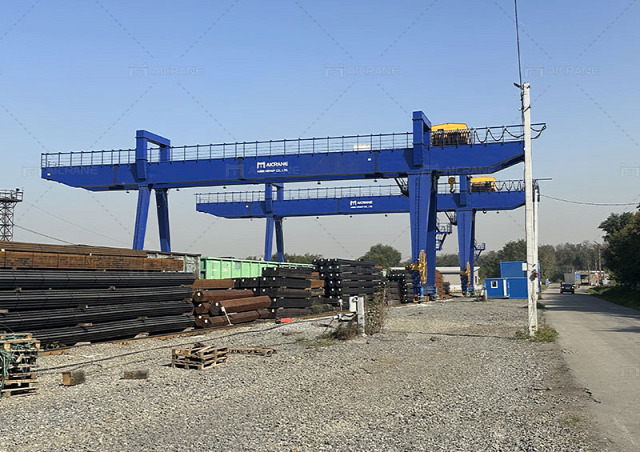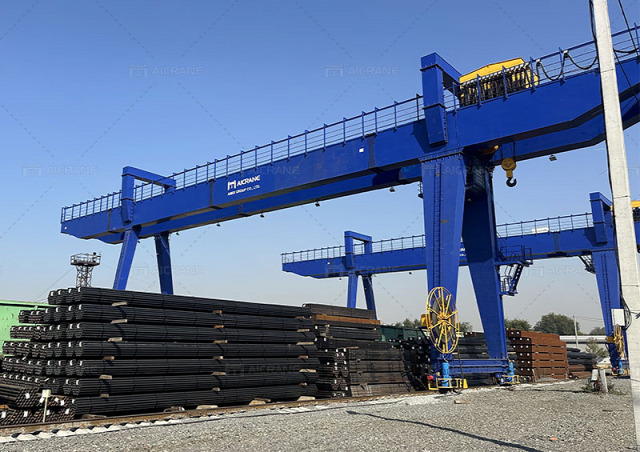Steel is one of the most commonly used materials in heavy industries, construction, manufacturing, and logistics. Whether it's for large construction projects, steel mills, or shipbuilding, lifting and moving steel materials requires equipment that is strong, precise, and reliable. This is where 30-ton gantry cranes come into play. These cranes are crucial in various applications involving the lifting, transporting, and positioning of steel materials. In this article, we’ll explore how 30-ton gantry cranes are specifically used for lifting steel materials, their advantages, safety considerations, and best practices for effective operation.

What is a 30-Ton Gantry Crane?
A 30 ton gantry crane for sale is a type of overhead lifting equipment that runs on tracks or rails. It consists of a bridge supported by two or more legs, with wheels or rail-mounted tracks at the base. The crane’s main lifting component is the hoist, which is capable of lifting loads up to 30 tons, making it suitable for heavy-duty operations. Gantry cranes come in various configurations, such as single-girder and double-girder designs, with the latter offering greater stability and load-bearing capacity.
30-ton gantry cranes are designed to operate in environments like steel mills, warehouses, construction sites, shipyards, and manufacturing plants, where the handling of large and heavy steel components is a regular task.
Applications of 30-Ton Gantry Cranes for Lifting Steel Materials
1. Steel Plate Handling in Steel Mills
Steel mills are high-demand environments where raw steel materials such as steel plates, bars, and coils need to be handled efficiently. 30-ton gantry cranes play a critical role in this setting by moving these heavy materials through various stages of processing. From unloading steel slabs from trucks or ships to transporting them across different workstations for further processing (such as cutting, welding, or bending), gantry cranes provide the precise control and strength needed.
The versatility of gantry cranes allows for the movement of steel plates with minimal effort. The ability to control the speed, direction, and lifting height ensures that delicate and high-value steel products are moved without damage. With the high lifting capacity of 30 tons, these cranes can lift and move even the heaviest steel plates without straining the crane's structural integrity.
2. Transporting Steel Beams in Construction Projects
In the construction industry, steel beams are commonly used for creating structural frameworks for buildings, bridges, and other large structures. Transporting these heavy materials from one area to another on construction sites requires equipment that is strong enough to handle the weight but also flexible enough to navigate through confined spaces.
A 30-ton gantry crane is ideal for this task. Its wide span allows it to lift large steel beams, while the hoist mechanism ensures that these beams can be positioned precisely where they are needed. These cranes can be used to move steel beams from delivery trucks to designated areas of the site, or to position them for assembly with other construction materials.
3. Handling Steel Coils in Manufacturing Plants
Steel coils are another product commonly handled by 30-ton gantry cranes. Steel coils are typically produced in rolls and are used in the automotive, appliance, and construction industries. Due to their size and weight, handling steel coils can be challenging. A 30-ton gantry crane equipped with special lifting attachments, such as coil hooks, can lift and transport these coils safely and efficiently.
The crane's hoist mechanism allows for smooth lifting and transportation of the coils, preventing damage to the coil’s structure. Furthermore, 30-ton gantry cranes provide excellent maneuverability, which is important for navigating the tight spaces of manufacturing facilities.

4. Moving Steel Components in Shipyards
Shipyards are another key area where 30-ton gantry cranes are heavily used. These cranes are essential in transporting large steel components used in shipbuilding, such as hull sections, bulkheads, and deck plates. Steel parts are often heavy and need to be positioned precisely during assembly.
The ability of the 30-ton gantry crane to lift such large items and place them accurately is crucial in the shipbuilding process. The gantry crane’s ability to operate with high precision allows for the accurate alignment of parts, which is critical for maintaining the integrity of the ship’s design.
Advantages of Using 30-Ton Gantry Cranes for Lifting Steel Materials
1. High Lifting Capacity
The 30-ton lifting capacity of these cranes is a key advantage. Steel materials, including heavy beams, plates, coils, and sections, often exceed the load capacity of standard overhead cranes. With a 30-ton double girder gantry crane, companies can handle a wide variety of steel products without the need for multiple lifting machines.
2. Improved Safety and Efficiency
Handling steel materials without proper equipment is dangerous and inefficient. A 30-ton gantry crane allows for safe lifting of heavy steel loads, reducing the risk of injury to workers and preventing damage to materials. These cranes can also operate at higher speeds and with greater precision than manual handling, increasing operational efficiency.
3. Cost-Effective Solutions
Investing in a 30-ton gantry crane can be more cost-effective than using smaller cranes for multiple lifts or relying on manual labor. The crane’s ability to lift heavier loads means fewer lifts are needed, reducing operational time and labor costs. Moreover, the durability of gantry cranes ensures that they offer long-term value for industries that frequently handle heavy materials.
4. Customizable Attachments
30-ton gantry cranes can be equipped with various attachments, such as spreader beams, coil hooks, or lifting slings, specifically designed for steel materials. These attachments allow for more secure handling of different types of steel products, providing additional versatility to meet specific lifting needs.
Safety Considerations
When operating 30-ton gantry cranes to lift steel materials, safety is paramount. The following safety precautions should be followed:
1. Regular Inspections
Before using the crane, it's important to inspect it for any signs of wear or damage. This includes checking the hoisting mechanism, crane legs, track rails, and electrical systems to ensure everything is functioning properly.
2. Proper Training for Operators
Operators should undergo proper training on how to safely operate 30-ton gantry cranes. Training should cover lifting techniques, safe handling practices, emergency procedures, and how to work with various steel materials. Properly trained operators will minimize the risk of accidents and ensure the safe handling of steel loads.
3. Use of Safety Equipment
Operators and workers in the vicinity of the crane should wear appropriate personal protective equipment (PPE), such as helmets, gloves, steel-toed boots, and safety harnesses. Additionally, warning signs and barricades should be used to mark off areas where crane operations are ongoing.
Conclusion
30-ton gantry cranes are indispensable tools for lifting and handling steel materials in a variety of industries. From steel mills to construction sites and shipyards, these cranes provide the power, precision, and flexibility required to move heavy steel products safely and efficiently. By improving productivity, enhancing safety, and providing cost-effective solutions, 30-ton gantry cranes play a vital role in the modern industrial landscape.
When operating 30-ton gantry cranes, safety, proper training, and regular maintenance are key to ensuring that the cranes perform optimally and continue to meet the demanding lifting needs of steel handling. By following best practices and leveraging the capabilities of these powerful cranes, industries can streamline their operations and ensure the successful handling of heavy steel materials.

